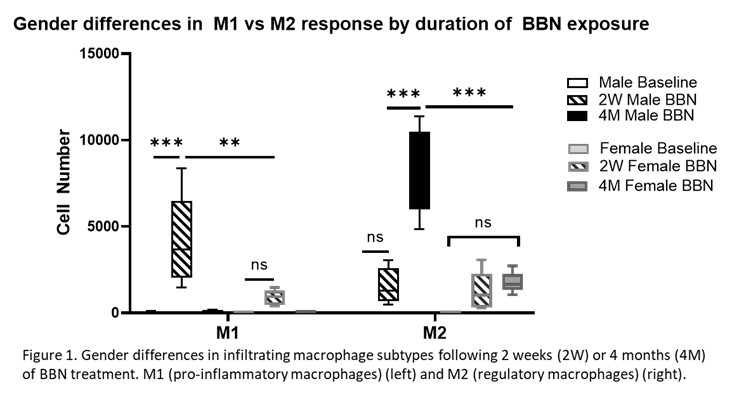Back
Poster, Podium & Video Sessions
Podium
PD12: Bladder Cancer: Basic Research & Pathophysiology II
PD12-06: Differential myeloid inflammatory response and tumorigenesis by gender in mouse model of bladder cancer
Friday, May 13, 2022
1:50 PM – 2:00 PM
Location: Room 244
Lauren Folgosa Cooley*, Joseph Podojil, Khyati Meghani, Yanni Yu, Stephen Miller, Joshua Meeks, Chicago, IL
- LC
Podium Presenter(s)
Introduction: Men are three times more likely to develop bladder cancer (BC) than women. Mouse models have demonstrated that androgens are necessary for BC tumorigenesis. Herein, we assess how gender influences the tumor microenvironment (TME) in a mouse model of BC.
Methods: Male and female C57Bl/6 mice were fed 0.05% N-butyl-N-(4-hydroxybutyl)-nitrosamine (BBN) in drinking water (n=20/gender) for up to 4 months. Bladder immune microenvironments were compared by flow cytometry, Luminex multiplex immunoassays, RNA-seq and histology. Multiple means with standard deviation and proportions were compared using two-way ANOVA with Tukey post-test or chi square, respectively.
Results: Males were significantly more likely to develop muscle invasive BC (p=0.05). BBN significantly increased CD45+ leukocyte infiltration regardless of gender (p < 0.0001). Males exhibited more robust myeloid responses compared to females (Figure 1). With short (2 week) BBN exposure, males increased pro-inflammatory M1 macrophages (p < 0.05) compared to females. With prolonged exposure in males, however, M1s decrease and regulatory M2 macrophages predominate (p < 0.05). Furthermore, cytokine analysis identified significantly greater monocyte chemoattractant protein 1 (MCP-1) in BBN-treated males (p=0.0001). RNA-Seq profiling with principal component analysis identified distinct clustering of male and female bladders, but signature from BBN-females closely resembled that of normal bladder.
Conclusions: Males exposed to BBN carcinogen are more likely to develop muscle invasive BC than females. These differences may be in part explained by the more regulatory TME in males with prolonged BBN exposure. Further investigation of the mechanism of protection in females may identify mechanisms for decreased incidence of BC in women.
Source of Funding: Urology Care Foundation, Kahlert Foundation

Methods: Male and female C57Bl/6 mice were fed 0.05% N-butyl-N-(4-hydroxybutyl)-nitrosamine (BBN) in drinking water (n=20/gender) for up to 4 months. Bladder immune microenvironments were compared by flow cytometry, Luminex multiplex immunoassays, RNA-seq and histology. Multiple means with standard deviation and proportions were compared using two-way ANOVA with Tukey post-test or chi square, respectively.
Results: Males were significantly more likely to develop muscle invasive BC (p=0.05). BBN significantly increased CD45+ leukocyte infiltration regardless of gender (p < 0.0001). Males exhibited more robust myeloid responses compared to females (Figure 1). With short (2 week) BBN exposure, males increased pro-inflammatory M1 macrophages (p < 0.05) compared to females. With prolonged exposure in males, however, M1s decrease and regulatory M2 macrophages predominate (p < 0.05). Furthermore, cytokine analysis identified significantly greater monocyte chemoattractant protein 1 (MCP-1) in BBN-treated males (p=0.0001). RNA-Seq profiling with principal component analysis identified distinct clustering of male and female bladders, but signature from BBN-females closely resembled that of normal bladder.
Conclusions: Males exposed to BBN carcinogen are more likely to develop muscle invasive BC than females. These differences may be in part explained by the more regulatory TME in males with prolonged BBN exposure. Further investigation of the mechanism of protection in females may identify mechanisms for decreased incidence of BC in women.
Source of Funding: Urology Care Foundation, Kahlert Foundation


.jpg)
.jpg)